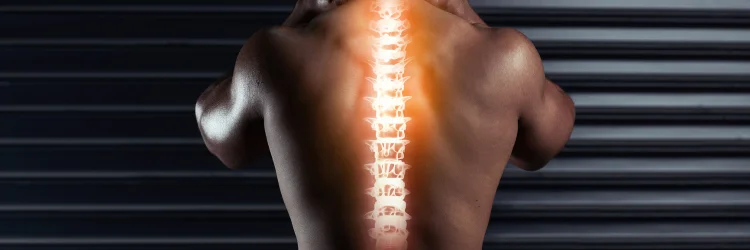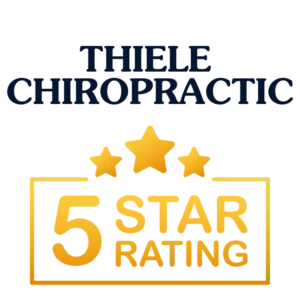Chiropractic Management of Postoperative Spine Pain: A Report of 3 Cases
Journal of Chiropractic Medicine
September 2013; Vol. 12; No. 3; pp. 168–175
Christopher M. Coulis DC, MS; Anthony J. Lisi DC; this study cites 39 references.
The objective of this article was to describe chiropractic care, including spinal manipulation for 3 patients with postsurgical spine pain. The surgeries included 1 cervical fusion, 1 lumbar discectomy, and 1 lumbar laminectomy.
Two patients were treated with high-velocity, low-amplitude spinal manipulation; 1 patient was treated with flexion-distraction mobilization.
KEY POINTS FROM THIS ARTICLE:
1) “High-velocity, low-amplitude manipulation has been shown to be a nonoperative treatment option for lumbar radiculopathy secondary to a herniated disk and for chronic lumbar discogenic pain with radiculopathy post-microdiscectomy.” [Important]
2) “Approximately 7.5% of patients experiencing chronic LBP elect to undergo spinal surgery.”
3) “The incidence of recurrent disk herniation after [lumbar] discectomy ranges from 2% to 18%.”
4) “Although numerous randomized controlled trials have shown spinal manipulation and/or mobilization to be safe and effective for the treatment of chronic neck pain and LBP [low back pain], these trials invariably have excluded patients who have undergone prior spine surgery.”
5) “Chronic pain after surgery is common.”
- About 20% of patients who have undergone various surgical procedures experience severe postoperative pain or only poor to fair pain relief despite pain management therapies.
- “Despite surgical intervention, up to 61% of patients continue to experience spinal pain after surgery.”
- Up to 66% of all chronic pain patients enrolled in pain centers in the U.S. are believed to experience failed back surgery syndrome. [Important]
- “The prevalence of postsurgical patients presenting to chiropractic practices ranges from 2.3% to 12%.”
- “Data suggest that chronic back pain post–spinal surgery should be treated nonoperatively unless progressive neurologic deficits exist.”
- “These patients may continue to seek treatment and are faced with numerous options for pain management and functional restoration, including chiropractic care.”
- “Very little evidence exists to guide chiropractic clinicians in the treatment of such patients.”
6) Prior Studies:
- Incidence:
- A 1994 study demonstrated that 3.8% of patients consulting chiropractic physicians had undergone at least one previous spinal surgery.
- A 1998 study noted that 2.3% of patients consulting a doctor of chiropractic had a history of at least one previous back surgery.
- A 1995 study found that 12% of cases of LBP and leg pain treated at a chiropractic teaching clinic had a history of previous low back surgery.
- A 1983 study presented 3 cases of sacroiliac syndrome post–lumbar fusion that responded well to HVLA manipulation.
- A 1996 study reported a case of back and leg pain post–lumbar discectomy that improved after HVLA manipulation and physical therapy modalities.
- Another 1996 study described a case of back and leg pain after 2 lumbar discectomies that responded to flexion-distraction and extensive active rehabilitation.
- A 2001 study presented a single case of cervical spine pain post–discectomy and fusion that tolerated instrumental adjustment without adverse reactions.
- A 2004 study demonstrated a positive response to a trial of lumbar manipulation and rehabilitative exercises in a patient who previously underwent lumbar microdiscectomy.
- Another 2004 study reported resolution of back pain in one case of postsurgical chronic cauda equina syndrome treated by HVLA manipulation.
- A 2010 study presented 8 cases of persistent low back pain or pelvic pain post–lumbar total disk replacement with positive outcome after high-velocity, low-amplitude spinal manipulation.
- A 2011 study treated 32 postsurgical patients with flexion-distraction mobilization, reporting no adverse events and noting benefit in all patients regardless of surgical procedure used.
Case 1
- 31-year-old man with acute LBP and bilateral lower extremity pain. For L4-L5-S1 disk herniation he had a L5 laminectomy, left L4-5 nerve root decompression, and right L5-S1 nerve root decompression performed 2.5 years previously.
- This patient did well for several years after surgery until he unloaded and stacked firewood, resulting in immediate severe low back pain with pain radiation into both legs.
- His “back pain was 6/10 on average and 8/10 at worst, with intermittent burning radiating pain into both legs.”
- “Prior treatment of his back pain included physical therapy, acupuncture, nonsteroidal anti-inflammatory drugs, and narcotics, without relief.”
- “Magnetic resonance imaging of the lumbar spine demonstrated a disk protrusion at L4-L5 and a disk extrusion at L5-S1 extending to the right lateral recess causing effacement of the right nerve root.”
- “He was assessed for appropriateness of HVLA spinal manipulation by provocation testing involving the application of graded preloading consistent with the manipulative procedure, which caused pain.”
- “At each visit, this provocation testing maneuver resulted in increased lower extremity pain; thus, manipulation was not performed.”
- Provocation testing with flexion-distraction mobilization was tolerated and therefore used.
- “The patient received 4 treatments over 4 weeks, noting benefit of both his low back and lower extremity pain without any adverse reaction.”
- “His pain levels decreased to 4/10 on average and 7/10 at worst, noting a decrease in the frequency and duration of acute episodes.” He also reported functional improvements.
- “His symptoms were more localized to the lower lumbar spine with decreased intensity of pain in the leg.”
- “The patient was satisfied with his response to treatment and wished to continue with his home exercise program and return for treatment on an as-needed basis.”
Case 2
- 47-year-old man with chronic neck, upper back, and right arm pain after a cervical spine fracture secondary to a 3-story fall and subsequent C3-T3 fusion 7 years previously. Pain was 6/10 on average and 8/10 at worst. He suffered daily urinary urgency.
- All movements, positions, and activities exacerbated his condition, with significant difficulty with right-hand grip and fine motor control.
- Prior treatment included intensive rehabilitation, trigger point injections, nonsteroidal anti-inflammatory drugs, opioid, and nonopioid analgesics.
- Adverse nerve root tension was noted with right upper limb tension test; DTRs were 1+ bilaterally at the biceps, triceps, and brachioradialis and 2+ bilaterally at the patella and Achilles.
- “He was able to tolerate articular provocation and pre-manipulative positioning; the patient received HVLA ‘thrust’ manipulation to the C1-2 segments bilaterally while supine and the T3-6 segments while prone.”
- He tolerated facet loading and pre-manipulative positioning without increased pain or radiation distally.
- “The patient has been treated 17 times over the past 7 years.” He experiences exacerbations periodically that respond to a short trial of care, usually consisting of 2 to 3 treatments.
- “Post-treatment, he typically reports a return to baseline pain and functional levels evidenced by a greater than 2-point decrease in numeric rating scale, increased cervical spine range of motion, and improved ability to perform his activities of daily living.”
- He reported subjective benefit and functional gain posttreatment without the presence of adverse effect.
- This is the first reported case of cervical spine HVLA manipulation post–cervical spine fusion.
Case 3
- 60-year-old man with chronic LBP and right lower extremity pain after falling off of a truck and experiencing an L3/L4/L5 disk herniation; a L3-L5 laminectomy was performed 27 years prior.
- Since surgery, he has had periods of pain resulting in numerous presentations to the emergency department.
- He suffered a 2-week exacerbation of lumbar spine pain with radiation to the right leg and foot, aggravated with sitting for more than 15 minutes, riding a bike, walking more than 100 yards, and sneezing/coughing. His pain was 7/10 on average and 10/10 at worst.
- Prior treatment included physical therapy and drugs (tricyclic antidepressants, acetaminophen, meloxicam, cyclobenzaprine, and opioids).
- “Magnetic resonance imaging of the lumbar spine demonstrated disk protrusion at L2-3, L3-4, L4-5, and L5-S1 with moderate to severe spinal stenosis and postoperative changes with minimal scarring.”
- “He was assessed for appropriateness of HVLA spinal manipulation and flexion-distraction mobilization and was able to tolerate pre-manipulative positioning and articular provocation.”
- “He was treated with flexion-distraction mobilization targeting the lumbar spine and side-posture HVLA manipulation of the lower lumbar spine at each visit.”
- He received 5 treatments over a 5-week period, reporting temporary relief of his low back and right leg pain. “He noted durable functional improvement: he tolerated driving 600 miles without exacerbation of his symptoms and reported increased walking distance prior to the onset of pain.”
- “The patient was satisfied with his response to treatment and wished to follow up as needed for exacerbation of lumbar spine or lower extremity pain or if he noted deterioration of his functional gains.”
7) The use of analgesics and/or anti-inflammatory drugs was ineffective, and was discontinued during the trial of chiropractic care for all 3 cases.
8) “It has been reported that movements/positions causing peripheralization of a patient’s symptoms are contraindicated, whereas movements/positions that centralize symptoms are appropriate.” [Key Point]
9) Flexion-distraction mobilization reduces intradiscal pressure.
10) “Chronic neck pain post–cervical spine fusion is common and may be attributed to numerous factors including surgery at the wrong level, insufficient removal of herniated or degenerative tissues, unrecognized second disk herniation, recurrence of herniation, unrecognized displaced sequestration, new disk herniation at a different level, epidural fibrosis/local arachnoiditis, or symptomatic arthritis of the posterior joints.”
- “In the untreated adjacent levels, increased motion and elevated intradiscal pressures have been associated with an increased risk of adjacent level syndrome, believed to be the cause of 25% of post–cervical fusion pain.” [Very Important]
- “Current evidence suggests that the zygapophyseal joint is the most common cause of posttraumatic chronic neck pain.” [Important]
11) Conclusions
- “This study presents 3 cases of spinal pain post–spine surgery in which chiropractic spinal manipulation and/or mobilization was used without significant adverse effects and with reported positive clinical outcomes.” [Key Point]
- “In these 3 cases, patients with postsurgical spine pain responded positively to chiropractic care.”
- This case series, along with the other cited studies, support the hypothesis that spinal manipulation/mobilization may be safe and effective for patients experiencing spinal pain after spine surgery. [Important]
- “In each trial, the patients reported being ‘satisfied’ with their overall outcome.”
COMMENTS FROM DAN MURPHY:
An important theme in this Article (and in others) is that if the “set-up” prior to an adjustment increases arm or leg pain (peripheralization), that doing the adjustment is probably not a good idea.
Article Review 08-07 also shows significant benefit for side-posture HVLA adjusting by chiropractors on patients who have failed to respond to surgery (and other interventions). These patients were also suffering from disabling chronic severe back and/or leg pain:
Spinal Manipulation in the Treatment of Low back Pain


